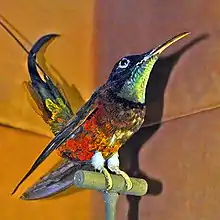Crimson topaz
The crimson topaz (Topaza pella) is a species of hummingbird in the family Trochilidae.
| Crimson topaz | |
|---|---|
.jpg.webp) | |
| Scientific classification | |
| Kingdom: | Animalia |
| Phylum: | Chordata |
| Class: | Aves |
| Order: | Apodiformes |
| Family: | Trochilidae |
| Genus: | Topaza |
| Species: | T. pella |
| Binomial name | |
| Topaza pella | |
 | |
| Distribution of Topaza pella | |
| Synonyms | |
Taxonomy
The crimson topaz was formally described by the Swedish naturalist Carl Linnaeus in 1758 in the tenth edition of his Systema Naturae under the binomial name Trochilus pella. [2] Linnaeus based his description on the "Long-tail'd red huming-bird" that had been described and illustrated by the English naturalist George Edwards in 1743 from a specimen owned by the Charles Lennox, the Duke of Richmond. The specimen had been collected in Suriname.[3] The specific epithet is from the Latin pellus meaning "dark-coloured".[4] The crimson topaz is now placed in the genus Tapaz that was introduced by George Robert Gray in 1840 with the crimson topaz as the type species.[5][6]
Three subspecies are recognised:[6]
- T. p. pella (Linnaeus, 1758) – east Venezuela, north Brazil, Guyana and Suriname
- T. p. smaragdulus (Bosc, 1792) – French Guiana and northeast Brazil (north of the Amazon)
- T. p. microrhyncha Butler, AL, 1926 – north-central Brazil (south of the Amazon)
Description
The crimson topaz can reach a length of 21–23 centimetres (8.3–9.1 in) in males (including bill abt. 5 cm and tail abt. 12 cm), while females reach 13–14 centimetres (5.1–5.5 in).[7] Both males and females weigh about 10 grams. It may be the second largest species of hummingbird after the giant hummingbird.
The male is notably larger and, with iridescent crimson plumage and sparkling green throat, more spectacular-looking than the female. Belly and breast are metallic orange-red. The wings are brown and are maroon in the lower part. The long tail coverts are golden green. They have short, slightly curved beaks that allow them to feed from a variety of local plants.[8]
Distribution and habitat
This species can be found in Brazil, Colombia, French Guiana, Guyana, Peru, Suriname, and Venezuela.[1][7] Its natural habitat is subtropical or tropical moist lowland forest up to 500 m.[7] They live in the upper and middle canopy, and are rarely seen on the ground.

Behaviour
These hummingbirds mainly feed on nectar of flowering trees in the canopy of the forest (Bromeliaceae and Ericaceae).[7][8]
References
- BirdLife International (2016). "Topaza pella". IUCN Red List of Threatened Species. 2016: e.T22687759A93168003. Retrieved 5 March 2020.CS1 maint: ref=harv (link)
- Linnaeus, Carl (1758). Systema Naturae per regna tria naturae, secundum classes, ordines, genera, species, cum characteribus, differentiis, synonymis, locis (in Latin). Volume 1 (10th ed.). Holmiae (Stockholm): Laurentii Salvii. p. 119.
- Edwards, George (1743). A Natural History of Uncommon Birds. Part 1. London: Printed for the author at the College of Physicians. p. 32, Plate 32.
- Jobling, James A. (2010). The Helm Dictionary of Scientific Bird Names. London: Christopher Helm. p. 295. ISBN 978-1-4081-2501-4.
- Gray, George Robert (1840). A List of the Genera of Birds : with an Indication of the Typical Species of Each Genus. London: R. and J.E. Taylor. p. 13.
- Gill, Frank; Donsker, David; Rasmussen, Pamela, eds. (January 2021). "Hummingbirds". IOC World Bird List Version 11.1. International Ornithologists' Union. Retrieved 29 January 2021.
- Schuchmann, K.L., Kirwan, G.M. & Boesman, P. (2016). Handbook of the Birds of the World Alive. Lynx Edicions, Barcelona
- Oiseaux-birds
Bibliography
- Arthur Lennox Butler: Mr. A. L. Butler exhibited some examples of Topaza pella which he had recently received from the neighbourhood of Pará. In: Bulletin of the British Ornithologists' Club. Bd. 46, 1926, S. 56–57 (online [abgerufen am 19. Juni 2014]).
- Da-Shih Hu, Leo Joseph, David Agro: Distribution, Variation, and Taxonomy of Topaza Hummingbirds (Aves: Trochilidae). In: Ornitologia Neotropical. Bd. 11, Nr. 2, 2000, S. 123–142
- Harry Church Oberholser: Catalogue of a collection of hummingbirds from Ecuador and Colombia. In: Proceedings of the United States National Museum. Bd. 24, 1902, S. 309–342
- Louis Augustin Guillaume Bosc: Description d'une nouvelle espèce de Grimpereau. In: Journal d'histoire naturelle. Bd. 1, 1792, S. 385–386, Tafel 20, Abbildung 5
